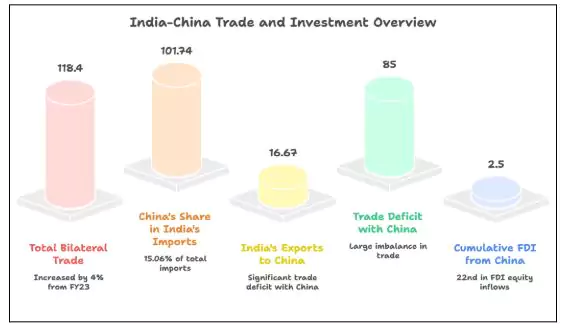In 2025, China withdrew over 300 engineers from Foxconn’s India plants and imposed export restrictions, highlighting its Geo- Economic strategy to undermine India’s growing high-tech manufacturing ambitions.
Geo-Economic Strategy
Geo-economic strategy refers to the use of economic instruments by states to advance geopolitical and strategic objectives, often leveraging trade, finance, technology, and sanctions as tools of foreign policy.
Main Tools of Geo-Economic Strategy
- Sanctions and Trade Restrictions: Countries use economic sanctions to exert pressure.
- NATO and Western sanctions on Russia in response to the Ukraine war, which aim to weaken Moscow’s economic and military capabilities.
- Energy Diplomacy: States manipulate energy supplies to influence others.
- Russia’s use of its gas exports to exert leverage over Europe.
- Investment, Aid, and Development Finance: Strategic deployment of development aid and loans shapes alliances.
- China’s Belt and Road Initiative finances critical infrastructure in developing countries to enhance Beijing’s influence, while the United States and Japan fund projects in Southeast Asia to counter China.
- Technology and Market Access: Control over critical technologies and supply chain access is a powerful tool.
- US-led chip export restrictions targeting China’s tech sector.
India’s Geo-Economic Policy
- Economic Diplomacy as a Tool: India uses foreign policy to absorb economic shocks and seize opportunities, focusing on trade, tech, and finance to advance national goals.
- For example India is showing diplomatic dissent and using dialogue to counter Trump’s Tariff.
- Balanced Strategic Autonomy: India maintains ties with major powers like the US, EU, Russia, and China without joining any bloc, preserving flexibility and economic options.
- Global Role for Growth: Through forums like G20, BRICS, and Quad, India pushes for developing nations’ concerns such as debt relief and digital public goods while supporting its own growth.
- Diversified Partnerships: India is expanding ties with the US, EU, Japan, Southeast Asia, Africa, and Latin America to reduce overdependence and strengthen economic resilience.
- Digital Diplomacy: By promoting platforms like UPI and India Stack, India aims to shape global digital standards and boost its presence in the global digital economy.
|
India’s Economic Ambition in Manufacturing and Technology
- Global Manufacturing Hub by 2047: India envisions becoming a top global manufacturing centre by 2047, anchored by flagship initiatives like Make in India and the Production Linked Incentive (PLI) schemes that incentivize production in sectors such as electronics, automotive, and pharmaceuticals.
- Embracing Industry 4.0: To enhance manufacturing competitiveness, India is adopting advanced Industry 4.0 technologies, including automation, robotics, and artificial intelligence, aiming to digitally transform its industrial base and improve productivity across sectors.
- Building High-Tech Self-Reliance: India is developing a strong domestic ecosystem for high-tech sectors like semiconductors, electronics, and digital platforms.
- For example, the Semicon India Programme aims to attract global chipmakers and reduce import dependence in critical tech hardware.
- Innovation-Driven Economic Diversification: The Vision 2047 roadmap promotes an innovation-led economy powered by a skilled workforce, efficient logistics, and digital infrastructure, aiming to align manufacturing with broader technological and economic transformation goals.
India’s Manufacturing Vulnerabilities
- Weak Infrastructure: India’s manufacturing sector suffers from poor transportation, unreliable power supply, and inadequate port connectivity, raising costs by 20-30% compared to competitors like Vietnam.
- Regulatory and Bureaucratic Constraints: Complex regulations, frequent policy changes, and cumbersome bureaucracy constrain ease of doing business; India still lags behind regional peers on global rankings for business climate and logistics.
- As per Economic Survey 2022-23 logistics costs in India have been in the range of 14-18 per cent of GDP against the global benchmark of 8 per cent.
- Import Dependence: India remains significantly reliant on imported semiconductors, chips, engines, and other critical components, making the high-tech sector vulnerable to external shocks and supply disruptions.
- Skills and Labour Shortages: There is a substantial gap between industry requirements and the skills of available labor, which limits productivity and scalability in critical manufacturing sectors.
- Limited Domestic Innovation and Supply Chains: The current manufacturing ecosystem lacks deep internal supply chains for advanced electronics and machinery, slowing India’s progress toward genuine self-reliance and reducing competitiveness with established economies like China.

China’s Geo-Economic Strategy Against India
- Control Over Human Capital: Withdrawal of trained Chinese engineers as in case of Foxconn, limits technology transfer and disrupts high-end electronics manufacturing setup in India.
- Rare Earth and Critical Minerals Monopoly: China restricted exports of gallium, germanium, graphite, and rare earth magnets essential for India’s electronics and EV sectors.
- Informal Equipment Export Bans: Verbal instructions and administrative delays restrict export of heavy machinery and electronic assembly tools to India.
- Supply Chain Disruption Tactics: China uses informal trade barriers to create uncertainty and cost escalation for Indian manufacturers.
- Weaponising Overcapacity: China floods global markets with underpriced goods to suppress competition and capture market share in emerging sectors.
Recommendations for India
- Build True Strategic Autonomy: India must reduce its external dependencies and develop internal strengths to respond independently to global power dynamics and shifting alliances, such as recent U.S. tariff hikes on Indian goods.
- Focus on Foundational Development: India needs a laser-sharp focus on fixing its infrastructure gaps, bureaucratic inefficiencies, and improving ease of doing business to build a globally competitive manufacturing ecosystem.
- Reduce Import Dependency in Key Sectors: To become a true manufacturing powerhouse, India must reduce reliance on foreign imports in critical areas like semiconductors, sensors, and engine components.
- Move Beyond “Screwdriver Technology”: India must develop indigenous capacity for high-value manufacturing, going beyond basic assembly to mastering advanced technologies and processes.
- Respond with Astute Policy and Execution: India can counter China’s economic coercion only through well-crafted industrial policy and disciplined implementation to develop self-reliant, high-tech manufacturing.
- Internalise the Lessons from China’s Strategy: India should understand that China’s aggressive moves stem from its domestic vulnerabilities and must respond with calibrated strategic planning and execution..
India-China Relation
- Dual Approach: India has adopted a two-track policy towards China maintaining a confrontational stance on security issues while sustaining cooperative economic engagement.
- Following the 2020 Galwan clashes, India banned Chinese apps and asserted that border peace is essential for normal relations, yet bilateral trade continued to grow.
- Core challenge: Despite the October 2024 border agreement, deep-rooted tensions from earlier clashes, especially the deadly 2020 LAC incident, continue to shadow diplomatic ties.
- The 2020 confrontation marked the first fatalities on the LAC in decades and triggered widespread strategic distrust.
- Economic Dependence: India remains highly dependent on Chinese imports in critical sectors such as electronics, solar power, and pharmaceuticals, exposing it to economic coercion.
- Example: In FY2024, China accounted for 15% of India’s merchandise imports, despite not exporting crude oil or LNG to India.
- Trade Imbalance: The bilateral trade imbalance heavily favors China, which increases India’s economic vulnerability and weakens its leverage in the relationship.
- In 2024, India’s exports to China were just $14.9 billion, while imports from China crossed $100 billion, a tenfold gap since 2005.
- Two Front threat : China’s military and diplomatic support to Pakistan during the May 2025 Kashmir crisis heightened Indian concerns about a potential two-front threat.
- Beijing’s overt military assistance to Islamabad during this crisis reinforced India’s perception of China as a direct security challenge.
- India’s De-risking Strategy: To build strategic autonomy, India is taking steps to reduce economic dependence on China, a goal where multilateral support is crucial through investment, technology, and supply chain diversification.
- India’s partners like the U.S. and Japan can aid India’s de-risking by helping build supply chain alternatives and restricting critical Chinese investments in sensitive sectors.
|
Conclusion
India must internalize the lessons from China’s geo-economic strategy of leveraging technology, trade, and human capital as tools of power. To counter economic coercion, India should build strategic autonomy through strong infrastructure, reduced import dependence, and indigenous innovation transforming from an assembly economy to a high-tech manufacturing powerhouse with global resilience.
![]() 7 Aug 2025
7 Aug 2025


